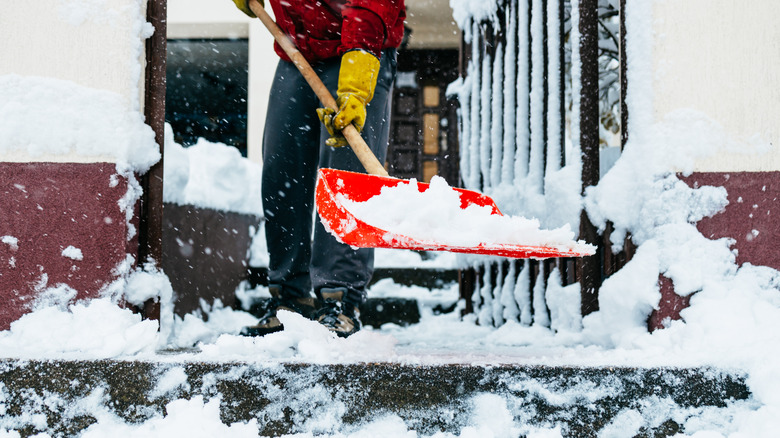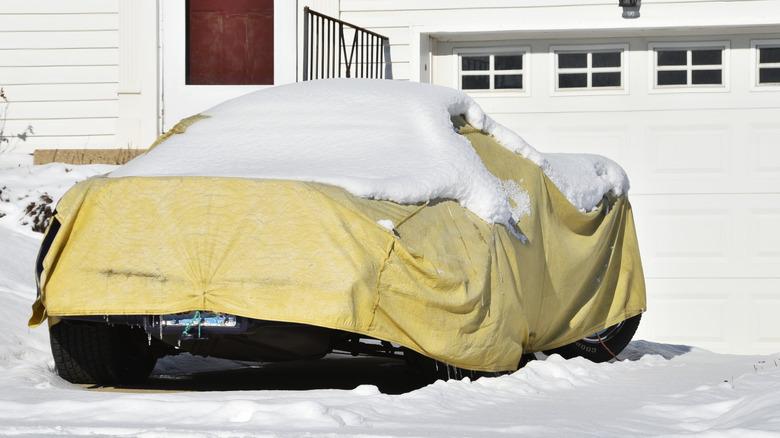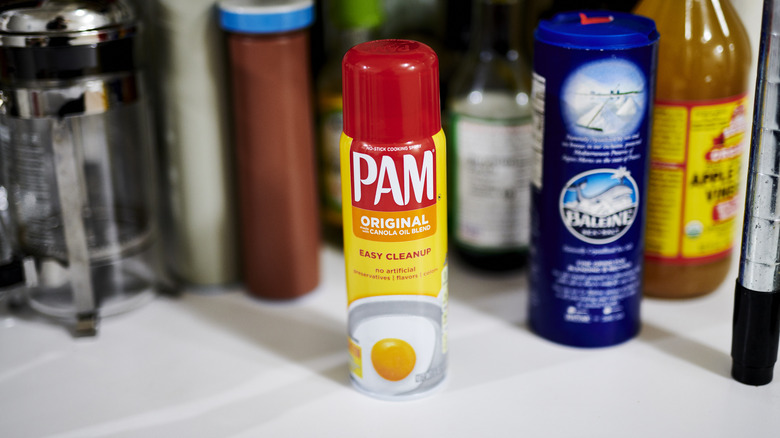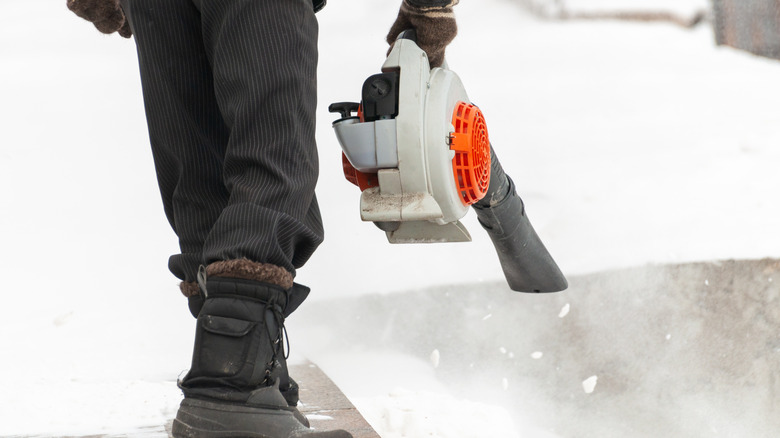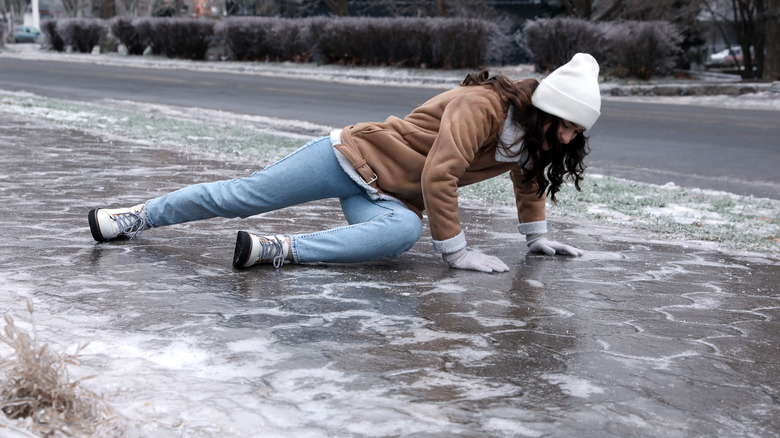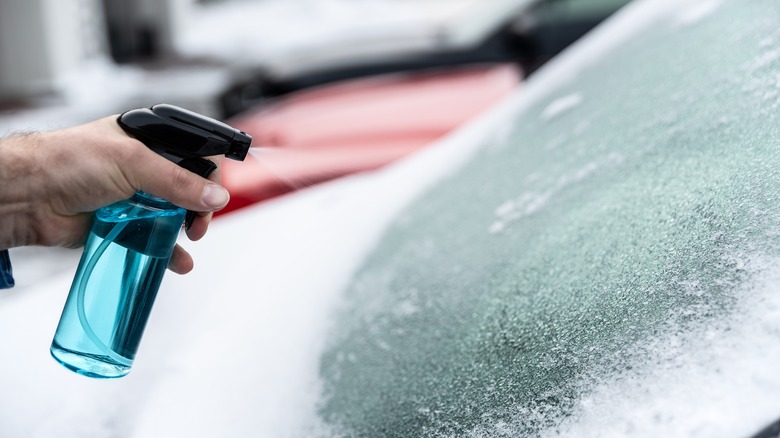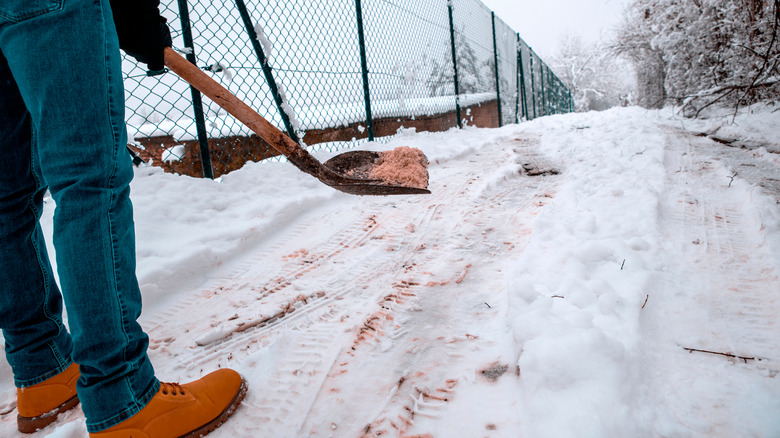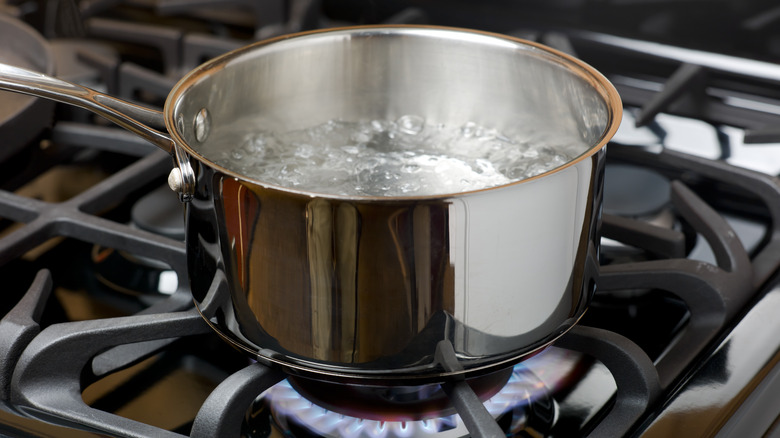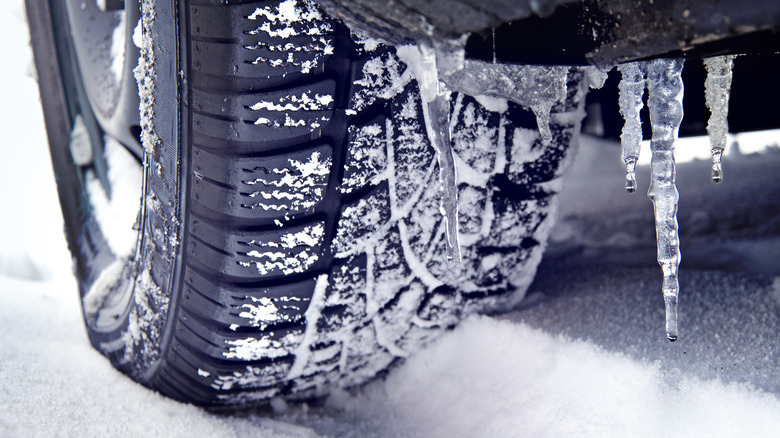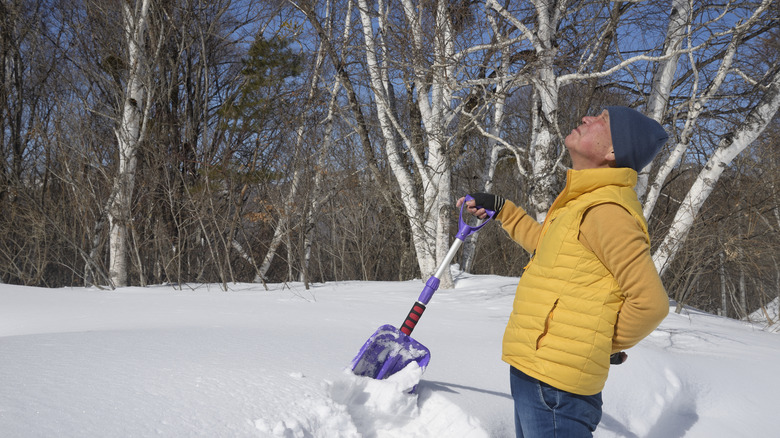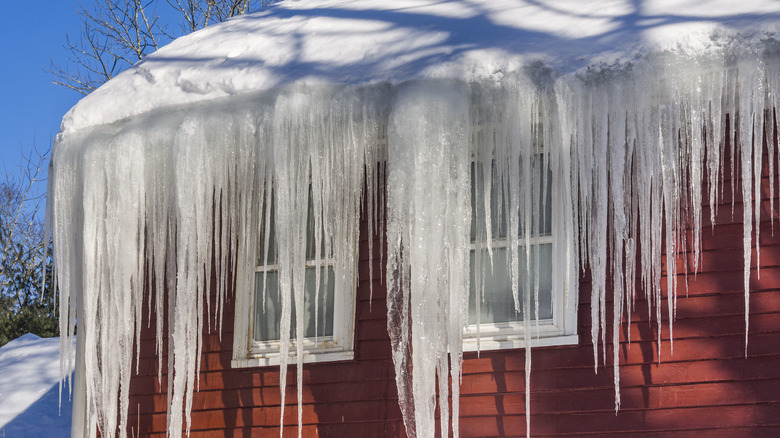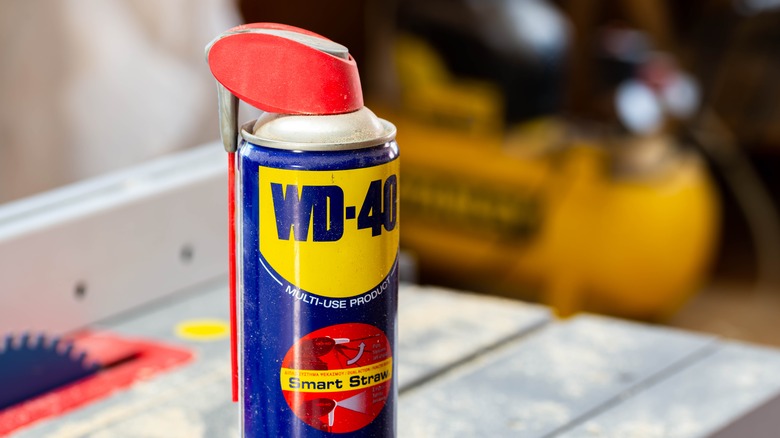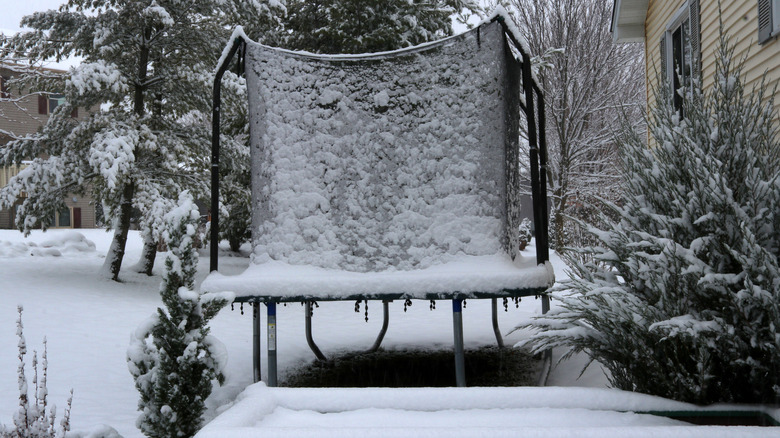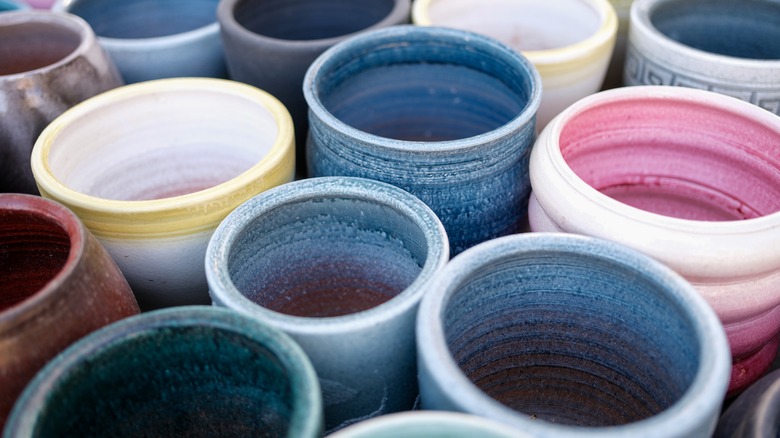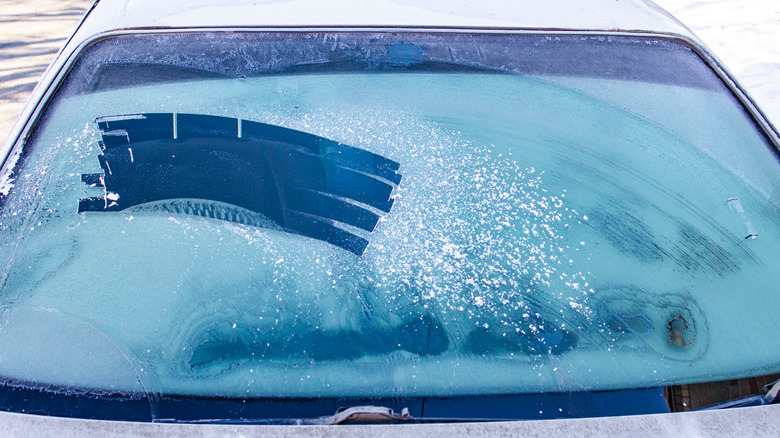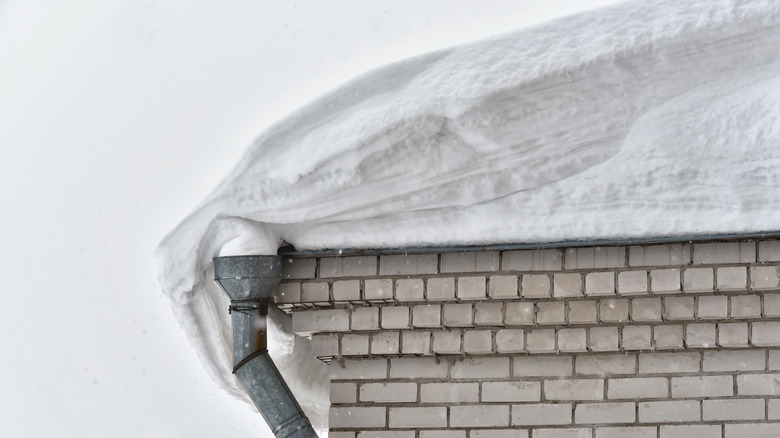The 15 Handiest Hacks To Take Care Of Snow And Ice Outside
We may receive a commission on purchases made from links.
Chilly, harsh winter weather might present the perfect opportunity to cozy up to the fireplace with a good book, but outside, it's not all fun and games. According to data shared by Value Penguin, severe winter weather has caused an average of over $200 million in damages to property each year for the past decade. Sometimes, damage from sudden freezes or unexpected snowfall is unpreventable, but regular maintenance can help decrease the chances of major issues and make your day-to-day activities much safer — no accidental tumbles thanks to frozen sidewalks, a buildup of ice on fragile parts of the home, or piles of snow that make the driveway inaccessible and slippery.
Unfortunately, this regular maintenance also takes time and effort, especially if you live somewhere that experiences more extreme cold snaps for several months of the year. Shoveling your driveway, removing ice from your roof, and defrosting your car to get to work nearly every day can feel like a never-ending cycle, but plenty of tips and tricks can help make the process much easier. A few hacks aren't going to completely eliminate the work it takes to make it through an icy winter, but they are likely to leave you wondering why you ever relied on the "normal" way to get things done.
1. Cover vehicles and high-traffic areas
If you don't give ice and snow a chance to stick to your surface in the first place, you won't have to struggle to clear it down the line. Covering your car ahead of snowfall or hard freeze is common, but you can also use this same line of thinking to protect your driveway or sidewalks. Simply lay down a tarp when you know the weather is about to get more severe, then pull it away and dump the snow once it dies down. For an added layer of ease, consider investing in heated mats so you never have to lift a finger.
2. Spray your shovel with cooking spray
Clearing the snow off your driveway is a simple process, but it can become more complex and frustrating when the snow starts sticking to your shovel. As it turns out, the solution to this issue is as simple as adding a bit of lubrication. Head into your kitchen, grab the cooking spray — any brand or type will do — and coat both sides of your shovel generously. If you don't have spray on hand, you can instead apply a bit of oil with a paper towel or brush to get the same smooth gliding result.
3. Try out your leaf blower
You might be used to getting the most use out of your leaf blower in the fall, but that doesn't mean that it has to be retired until the foliage starts to fill out again. If you're dealing with thin coats of snow — closer to a dusting than a full-blown blanket — a leaf blower will likely have enough power to clear off your driveway, especially if you're committed to tackling snowfall before it has a chance to pile up. Next time you go out to shovel, you might make your driveway snow removal easier.
4. Give yourself some traction
The most challenging part of winter maintenance is making it through without taking a cartoon-style tumble — thanks to a lack of traction on icy or snowy surfaces. Sure, you could throw on a pair of lug-sole boots and get to work, but if you need a bit of extra help, try sprinkling some salt or sand on the surface to decrease the slip factor. In a pinch, cat litter can also work, but beware — most brands will absorb water and quickly turn into a mess of sticky clay rather than a gritty, stable surface.
5. Make a DIY ice melt spray
Working through a thick layer of ice on your windshield or windows requires quite a bit of elbow grease, but spraying or sprinkling something meant to melt it can help speed up the process. Unfortunately, most people don't have a lot of options available at a moment's notice, and many of these deicers contain chemicals that can be damaging to the environment. Instead, consider making your own out of common household ingredients. Combine 2 parts rubbing alcohol or vinegar with 1 part water in a spray bottle, then spritz liberally to loosen up thick layers of ice.
6. Preemptively salt your surfaces
If you know a particularly heavy snowfall is heading in, consider taking a page from the professionals' book and try salting your driveway and sidewalk before it hits. Of course, you can always do the same after the snow has fallen, but salting preemptively ensures that nothing will stick and build up, making your shoveling job much easier down the line. Instead of having to soak in from the top down, the salt will form a layer of briny slush that can help prevent snow from sticking and slippery black ice from solidifying.
7. Use boiling water to clear pavement
The easiest way to get rid of ice and snow is melting it, but many people forget how simple the process can be. If you don't want to make a solution that will help encourage ice to melt, just boil water. A dump of a kettle can help turn stubborn ice and compacted snow into slush that's a lot easier to clear away. Just be careful where you pour hot water — it's fine on areas like driveways and sidewalks, but stay away from plastic and glass. It's also important to consider where the water will flow, as it will likely refreeze after it cools.
8. Use room temperature water for delicate surfaces
Some materials, like glass, plastic, and rubber, don't respond well to extreme changes in temperature or high heat. While it might be tempting to pour hot water on your frozen windshield or tires to help speed up the melting process, this is almost never a good idea. Instead, if you need to defrost these surfaces quickly, pour on a bit of room temperature or slightly warm water to get things going. It might not do much if the air is cold enough to cause the water to quickly refreeze, but it's a good hack for milder, icy days.
9. Invest in an ergonomic shovel
If you dread shoveling snow because of the soreness it causes in your back, you're not alone. Repeatedly digging and lifting a shovel full of heavy snow can wreak havoc on your body, especially if you're using the wrong size or type of shovel. Investing in something more ergonomic can take a lot of this load off your back so you can clear your driveway with ease. Try an option like this Outvita Snow Shovel with Wheels to bypass lifting altogether, or go for the Snow Joe Shovelution Strain-Reducing Snow Shovel with two handles.
10. Decrease the temperature of your attic, if possible
If you live in an area with super cold winters, you're likely already familiar with ice dams. Essentially, these buildups of ice and snow happen when snow on the roof melts — due to the home's heat — and refreezes. Large icicles form along the gutters, left untouched for long enough, can weigh down and break off parts of your home. To prevent this, try either decreasing the temperature of your upper floor or attic or investing in better insulation so the snow won't start the cycle of melting and refreezing.
11. Use WD-40 to prevent frozen locks
WD-40 is well known for its myriad of uses, from removing rust stains from concrete to cleaning up tree sap, but it's not only good for tidying up messes. If you have a padlock on a door or gate that frequently freezes up when temperatures drop, spray a bit of WD-40 in the keyhole, allow it to set in, and wipe off the outside so there is no oily residue. This coating will help prevent moisture from seeping in and freezing, ensuring your lock will remain functional despite the extreme conditions outside.
12. Put a folding table under trampolines
If you have a trampoline in your yard and you've decided to forgo breaking it down and storing it for the winter season, you must be cautious about the snow and ice collecting on the surface. A small amount is fine, but thick layers of snow put significant stress and weight on the fabric and strings. To support the trampoline from underneath, consider sliding a folding table underneath. It will essentially act as a crutch if the trampoline's surface begins to sag under the weight of the snow and ice on top.
13. Use an empty flower pot to spread salt
If you plan on utilizing salt to melt the snow and ice on your surfaces but don't have anything to help evenly spread it, consider using an empty flower pot for more precise application. Most flower pots have a drainage hole to help prevent root rot, but this small hole can act as a dispenser for salt, too. Fill up your pot with salt, then grab by the rim and lightly shake to apply — make sure you fully clean it out before you use it to hold any plants — excessive salt in soil can be damaging.
14. Use a bag full of warm water instead of scraping windows
Using a windshield scraper to clear off ice is one of the more efficient methods, especially if you need to quickly create a hole to see through on your car's windshield, but it can be tedious work if you try to defrost the entire thing. Instead, try using a hack that's been making the rounds on the internet thanks to its simplicity and efficiency: filling a plastic bag with slightly warm water and rubbing it over the icy surface. Make sure the water is warm, not hot, and slide the bag around over the ice until it's melted.
15. Use a rope to cut through snow piled on the roof
If your roof isn't adequately pitched, snow can pile up quickly and create a thick coat, especially after a heavy snowfall. Getting up there to clear it is difficult and dangerous, but if you're feeling creative, consider using a rope to cut through the layer and pull it down. Grab a friend and toss a long rope over the roof; they can catch the other end. Move it back and forth like a saw, pulling towards the roof edge to cut through and knock off a thick layer.
